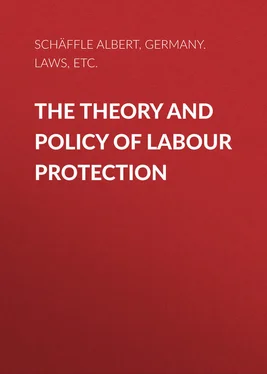Albert Schäffle - The Theory and Policy of Labour Protection
Здесь есть возможность читать онлайн «Albert Schäffle - The Theory and Policy of Labour Protection» — ознакомительный отрывок электронной книги совершенно бесплатно, а после прочтения отрывка купить полную версию. В некоторых случаях можно слушать аудио, скачать через торрент в формате fb2 и присутствует краткое содержание. Жанр: Юриспруденция, Юриспруденция, foreign_antique, foreign_prose, на английском языке. Описание произведения, (предисловие) а так же отзывы посетителей доступны на портале библиотеки ЛибКат.
- Название:The Theory and Policy of Labour Protection
- Автор:
- Жанр:
- Год:неизвестен
- ISBN:нет данных
- Рейтинг книги:5 / 5. Голосов: 1
-
Избранное:Добавить в избранное
- Отзывы:
-
Ваша оценка:
- 100
- 1
- 2
- 3
- 4
- 5
The Theory and Policy of Labour Protection: краткое содержание, описание и аннотация
Предлагаем к чтению аннотацию, описание, краткое содержание или предисловие (зависит от того, что написал сам автор книги «The Theory and Policy of Labour Protection»). Если вы не нашли необходимую информацию о книге — напишите в комментариях, мы постараемся отыскать её.
The Theory and Policy of Labour Protection — читать онлайн ознакомительный отрывок
Ниже представлен текст книги, разбитый по страницам. Система сохранения места последней прочитанной страницы, позволяет с удобством читать онлайн бесплатно книгу «The Theory and Policy of Labour Protection», без необходимости каждый раз заново искать на чём Вы остановились. Поставьте закладку, и сможете в любой момент перейти на страницу, на которой закончили чтение.
Интервал:
Закладка:
A French delegate, M. Delahaye, read out the following suggestion, which he proposed in his own name: “An industrial establishment denotes any house, cellar, open, closed, covered or uncovered place in which materials for production are manufactured into articles of merchandise. Moreover, a certain number (to be agreed on) of workmen must be engaged there, who shall work for a certain number (to be agreed on) of days in the year, or a machine must be used.”
The Spanish delegate stated that he would refrain from voting on the question, because he was of opinion that instead of using the term “industrial establishment,” it would be better to say “the work of any industries and handicrafts which demand the application of a strength greater than is compatible with the age and physical development of children and young workers.” According to his opinion no weight ought to be attached to the consideration whether the work is carried on within or outside of an establishment. After a discussion between the delegates from France, Belgium and Holland, and after receiving from the Luxembourg delegate a short analysis of foreign enactments on this point, the Committee unanimously adopted a proposal made by the delegates from Great Britain, and supported by Belgium, Germany, Hungary, Luxembourg, and Italy. The proposal was as follows: “By ‘industrial establishments’ shall be understood those which the Law regulating work in the various countries shall designate as such whether by means of definition or enumeration.”
A consideration of the discussions raised in paragraphs 1 to 5 results in the following definition of Labour Protection: the extraordinary protection extended to those branches of industrial wage-labour which claim, and are recognized as requiring, protection against the dangers arising out of service relations with certain employers, such protection being exercised by special applications of common law, punitive and administrative, either through the regular channels or by specially appointed administrative, judicial, and representative organs.
The Resolutions of the Berlin Conference, and the protective measures submitted to the German Reichstag early in the year 1890, have, as we shall find, strictly confined themselves to this essentially limited definition of Labour Protection.
It appears as though hitherto no clear theoretical definition of the idea of Labour Protection has been forthcoming. But the necessity for drawing a sharp distinction at least between Labour Protection and all other kinds of care for labour is often felt. Von Bojanowski speaks very strongly against vague extensions of the meaning: “The matter would become endlessly involved,” he says, “if, as has already happened in some cases, we were to extend the idea of protective legislation to include all such enactments (arising out of other possibilities based upon other considerations) as grant aid to workers in any kind of work or in certain branches of work, or such as are based on the rights of labour as such, and are therefore general in their application, or such as seek to further all those united efforts which are being made in response to the aspirations of the working population or from humanitarian considerations. This would result either in confounding it with an idea which we ought always carefully to distinguish from it, an idea unknown in England, that of the so-called ‘committee of public safety,’ or it would lead to more or less arbitrary experiments.”
CHAPTER II.
CLASSIFICATION OF INDUSTRIAL WAGE-LABOUR FOR PURPOSES OF PROTECTIVE LEGISLATION. – DEFINITION OF FACTORY-LABOUR
Those forms of industrial wage-labour which are dealt with by protective legislation do not all receive the same measure of protection, nor are they all dealt with according to the same method. This is only to be expected from the constitution of Labour Protection, which is an extraordinary exercise of State interference in cases where it is specially necessary.
All over the world we find that industrial wage-labour requires protection of various kinds, differing, that is, not only in its nature but in the course and method of its application. On account of these very differences, before we can go a step further in the elucidation of the Theory and Policy of Labour Protection, we must divide industrial wage-labour into classes, according to the kind of protection which is needed, and the manner in which such protection is applied by protective legislation. It will now be our task, therefore, to classify them, and to be sure that we arrive at a clear idea of the various classes into which they fall for the purposes of protective legislation, some of which may not perhaps be readily apparent at first sight.
The varieties of protection needed by industrial wage-labour arise, partly out of dangers peculiar to the particular occupation in which the wage-labourer is employed, and partly out of the personal characteristics and position of the labourer to be protected; i. e. they are partly exterior and partly personal.
When the protection is against exterior dangers we have to consider sometimes the great diversity of conditions in the different occupations and industries, and sometimes the special manner in which workmen may be affected within the limits of a single occupation peculiar to some special branch of industry. When the protection is of the kind which I have called personal, the need for it arises partly out of the special dangers to which the protected individual is liable outside the actual limits of his business, partly out of the special dangers attached to his position in that business.
Hence results the following classification of industrial wage-labour, according to the kind of protection required: —
I. Labourers requiring protection against exterior dangers:
a. According to the kinds of occupation:
1. Having reference to the different branches of industry:
Wage-labour in mining, manufacture, trade, traffic and transport, and in service of all kinds.
2. Having reference to the special dangers of employment within any particular branch of industry: dangerous – non-dangerous work.
b. According to type of business:
1. Having reference to the position or personality of the employer:
Wage-labour under private employers – wage-labour under government.
2. Having reference to the choice of the labourers by the employer, and the nature of their mutual relations.
Factory-labour,
Quasi-factory labour (especially labour in workshops of a similar nature to factories), other kinds of workshop labour,
Household industries (home-labour),
Family labour.
II. Labourers requiring protection against personal dangers:
a. Having reference to the common need of protection as men and citizens.
1. Adult – juvenile workers;
2. Male – female workers;
3. Married – unmarried female workers;
4. Apprentices – qualified wage-workers;
5. Wage-workers subject to school duties – exempt from school duties,
b. Having reference to the need of protection arising out of differences in the position occupied by the wage workers in the business:
Skilled labourers (such as professional wage-workers, business managers, overseers and foremen; or technical wage-workers, mechanics, chemists, draughtsmen, modellers); unskilled labourers.
A glance at existing legislation on Labour Protection, or even only at the various paragraphs of the von Berlepsch Industrial Code Amendment Bill, clearly shows the definite significance of all these foregoing classes in the codification of protective right. Each one of these classes is treated both generally and specifically in the Labour Acts.
Читать дальшеИнтервал:
Закладка:
Похожие книги на «The Theory and Policy of Labour Protection»
Представляем Вашему вниманию похожие книги на «The Theory and Policy of Labour Protection» списком для выбора. Мы отобрали схожую по названию и смыслу литературу в надежде предоставить читателям больше вариантов отыскать новые, интересные, ещё непрочитанные произведения.
Обсуждение, отзывы о книге «The Theory and Policy of Labour Protection» и просто собственные мнения читателей. Оставьте ваши комментарии, напишите, что Вы думаете о произведении, его смысле или главных героях. Укажите что конкретно понравилось, а что нет, и почему Вы так считаете.












![Edward Ellis - Adrift on the Pacific - A Boys [sic] Story of the Sea and its Perils](/books/753342/edward-ellis-adrift-on-the-pacific-a-boys-sic-s-thumb.webp)